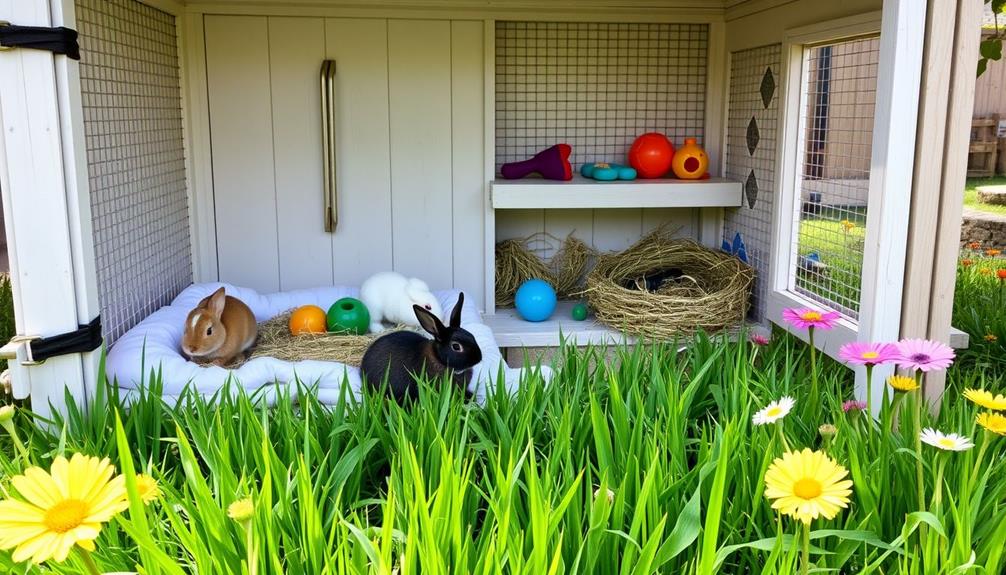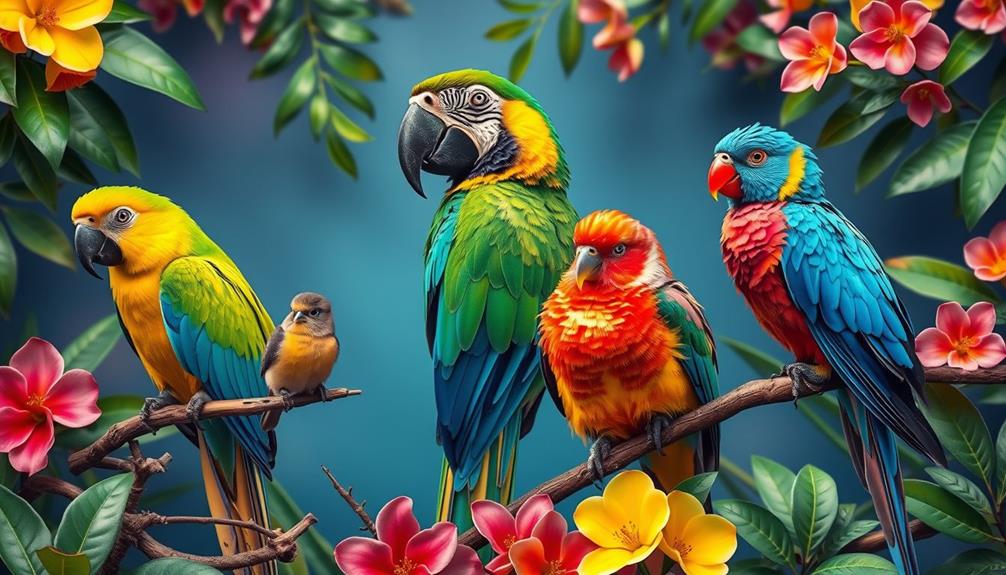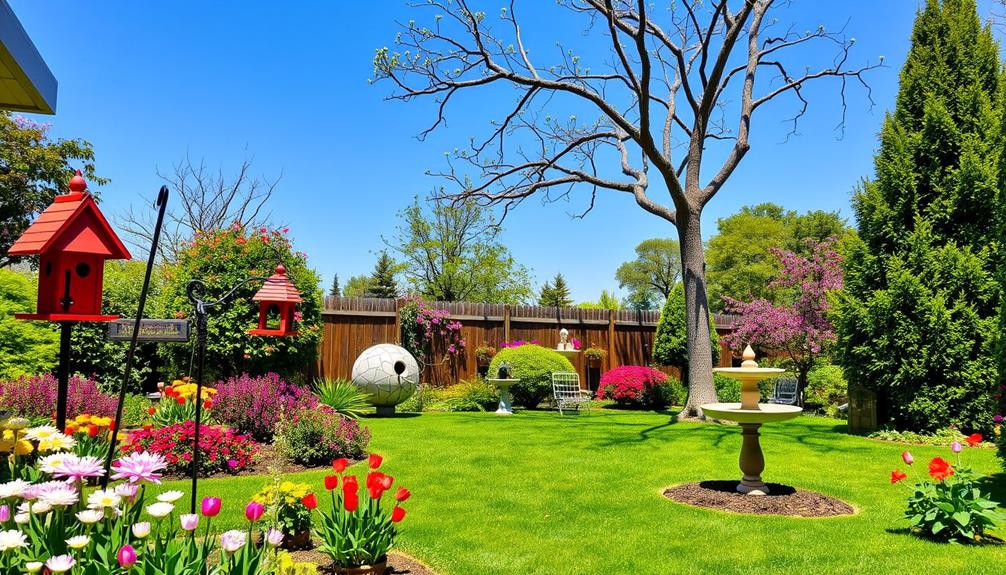Creating the perfect home environment for your rabbit means prioritizing their needs. Provide a spacious living area, ideally at least 10ft x 6ft x 3ft, with designated spots for sleeping, eating, and toileting. Make certain it's well-ventilated, clean, and safe, with sturdy, escape-proof enclosures. Include hiding spots to reduce stress and allow for regular exercise. Set up a hygienic space by cleaning daily and guaranteeing fresh water is always available. Finally, keep an eye on their diet, focusing on high-quality grass hay. If you want to guarantee your rabbit thrives, there's more to explore.
Key Takeaways
- Provide a spacious living area of at least 10ft x 6ft x 3ft for pairs of rabbits to ensure free movement and comfort.
- Ensure continuous access to fresh water in stable, heavy ceramic bowls, and monitor for cleanliness and availability.
- Maintain a clean and hygienic environment with daily waste removal and weekly deep cleaning using pet-safe products.
- Designate separate areas for sleeping, eating, and toileting, and incorporate hiding spots and enrichment activities to reduce stress.
- Regularly inspect housing for hazards and ensure it is weatherproof, secure, and suitable for the rabbits' needs.
Understanding Rabbit Needs
Understanding the needs of rabbits is fundamental for guaranteeing their happiness and health. Rabbits need a spacious living area that measures at least 10ft x 6ft x 3ft for pairs, allowing them to run, jump, and stretch freely. A well-ventilated environment is essential for their well-being, so make certain the space is dry and hygienic, with clean bedding to keep them comfortable.
Designate specific areas for sleeping, eating, and toileting to maintain cleanliness. Additionally, providing effective training tools can help in managing their behavior and guaranteeing they adapt well to their environment.
Rabbits also require an exercise area where they can engage in daily physical activity and mental stimulation. Providing toys and opportunities for social interaction is critical to keep them from getting bored. Since rabbits are social animals, companionship is fundamental; they thrive when living in pairs or groups.
Additionally, adequate shelter is necessary to protect them from predators and harsh weather. Guarantee they've access to shade in summer and warmth in winter to help them feel safe.
Ideal Living Spaces
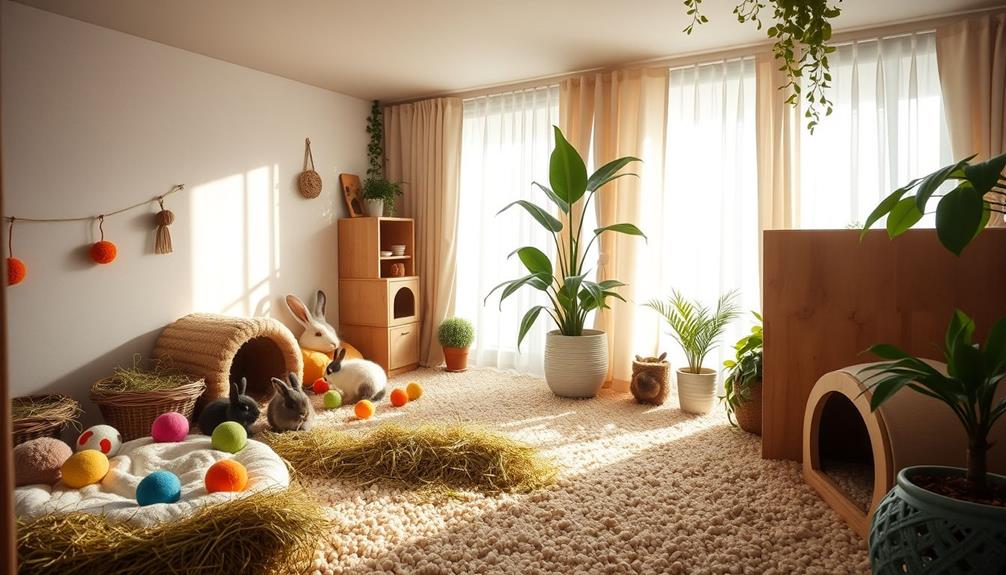
When setting up your rabbits' living space, it's essential to take into account both their space requirements and safety measures.
A minimum area of 10ft x 6ft x 3ft gives them room to move freely, while secure compartments guarantee they feel safe and protected.
Incorporating various safety features can also enhance their environment.
Don't forget to include hiding spots and enrichment activities to keep them happy and engaged.
Space Requirements for Rabbits
Creating a suitable living space for rabbits is vital for their happiness and well-being. The minimum recommended living space for a pair of rabbits is 10ft x 6ft x 3ft. This size allows for adequate running, jumping, and stretching, ensuring they stay happy and healthy.
If indoors, make sure to provide at least two compartments for sleeping and eating, each measuring 150-180cm in length, so they can fully stretch out. Incorporating a variety of perspectives on healthy living trends can also help you understand how to provide the best care for your pets.
For outdoor housing, choose a draught-free, weatherproof setup that's elevated to avoid moisture. It's important that your rabbits have access to sunlight and fresh air.
A well-designed living space should also include safe hiding places, allowing your rabbits to feel secure and reduce stress. Additionally, continuous access to exercise areas is essential. These areas encourage daily movement, preventing boredom and promoting health.
Safety and Security Measures
A safe and secure living space is essential for your rabbits' well-being. To keep your furry friends happy, make certain their habitat is spacious—at least 10ft x 6ft x 3ft for pairs. Use sturdy fencing and enclosures to create a secure habitat, which prevents escapes and protects against predators. Incorporate hiding spots to give your rabbits a sense of safety.
Additionally, it's beneficial to maintain a routine cleaning schedule, similar to essential items for a home cleaning kit, to make certain their living environment remains hygienic and safe.
Your rabbits need a well-ventilated and dry shelter that's draught-free and weatherproof. This protects them from extreme temperatures and direct sunlight. Make it a habit to clean their living space daily, as cleanliness contributes to their overall health and safety.
Regularly inspect the area for hazards like toxic plants, electrical cables, and sharp objects. This proactive approach helps maintain a safe environment for your rabbits.
Don't forget to add enrichment items, such as toys and tunnels, to promote exercise and mental stimulation. This keeps boredom at bay and encourages natural behaviors, enhancing their quality of life.
Indoor Housing Requirements
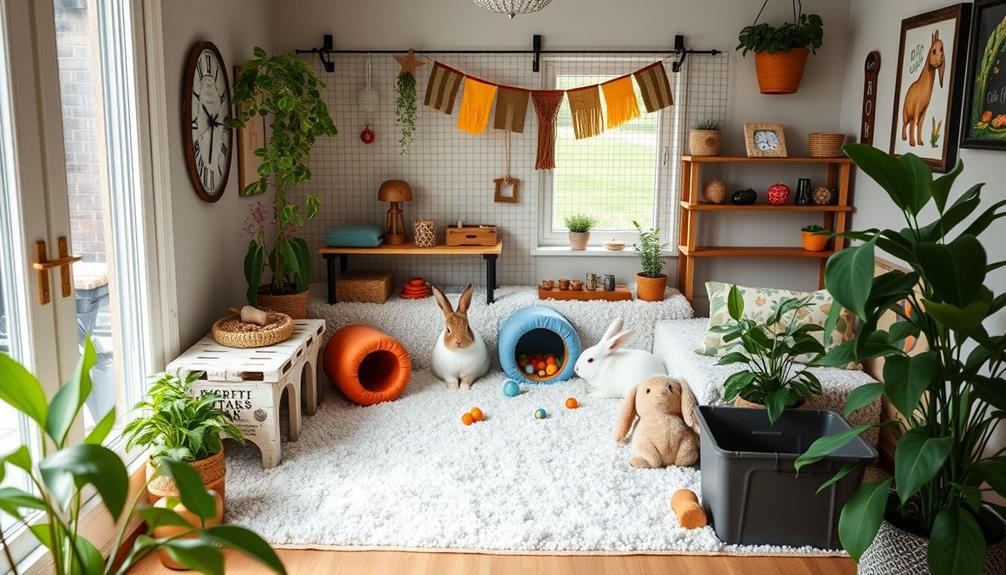
Indoor housing for rabbits must prioritize space and safety to guarantee your furry friend thrives. Aim for a minimum space of 4 feet long, 2 feet wide, and 4 feet tall to provide ample movement and comfort.
A secure accommodation should include designated areas for sleeping, eating, and toileting, ensuring adequate ventilation to maintain a healthy environment. Regular physical activity is also essential for your rabbit's well-being, as it supports their overall health and happiness, similar to how holistic lifestyle approaches can alleviate menopause symptoms in humans.
You'll want to create separate sleeping areas and designated toilet areas to simplify cleaning and promote hygiene. This setup not only keeps the living space tidy but also helps your rabbit feel safe and secure.
Be mindful of potential hazards in the indoor environment, such as electrical cables and heat sources, as these can cause injuries or distress.
Regular monitoring of indoor temperature and humidity levels is vital. Keeping these conditions stable prevents discomfort and potential health issues for your rabbit.
With the right indoor housing, you'll be able to create a safe haven that allows your pet to express natural behaviors while enjoying a healthy and happy life. Prioritize these requirements, and your rabbit will surely appreciate the care you provide.
Outdoor Housing Considerations

When setting up outdoor housing for your rabbit, it's essential to guarantee it's both weatherproof and secure.
To achieve this, consider incorporating features such as proper drainage systems and insulation materials to protect them from harsh elements and potential predators, so consider sturdy structures and escape-proof features.
Don't forget to provide fresh water at all times and check it regularly, especially during cold weather.
energy-efficient systems can also be beneficial for maintaining a comfortable environment.
Weatherproofing and Security Measures
Ensuring your rabbits have a safe and comfortable outdoor environment requires careful attention to weatherproofing and security measures.
Start by selecting a sturdy housing structure that protects against harsh weather and is elevated to prevent moisture accumulation, which can lead to health issues. It's important to use materials that are weather-resistant and designed for outdoor use, similar to the considerations for outdoor ceiling fans that enhance comfort.
Make sure the shelter is draught-free, providing relief from direct sunlight and strong winds.
In addition to housing, secure fencing is essential. Your fencing should be escape-proof and predator-resistant to keep your rabbits safe from potential threats.
Regular inspection of the outdoor area is vital to identify hazards, ensuring a secure environment. Keep an eye out for:
- Toxic plants that could harm your rabbits
- Sharp objects that pose a risk of injury
- Signs of moisture accumulation that could lead to health issues
- Areas where predators might gain access
Access to Fresh Water
Providing access to fresh water is just as important as securing your rabbits' outdoor environment. Fresh water must be readily available at all times to maintain hydration and overall health. When setting up their outdoor housing, consider using heavy ceramic bowls instead of sipper bottles. These bowls are less likely to tip over, making it easier for your rabbits to drink.
Additionally, confirming that your rabbits have a clean and safe environment can help reduce stress, which is vital for their well-being, much like how emotional attachment in pets plays a role in their behavior and health.
It's essential to monitor outdoor water sources, particularly during colder months, to guarantee they don't freeze. Your rabbits need continuous access to liquid water, so check their water containers regularly.
Additionally, place those containers in shaded areas to prevent the water from becoming too warm in hot weather, promoting better hydration.
To maintain hygiene, clean the water containers daily. This practice helps prevent bacterial growth, assuring your rabbits drink from clean sources.
Hygiene and Maintenance
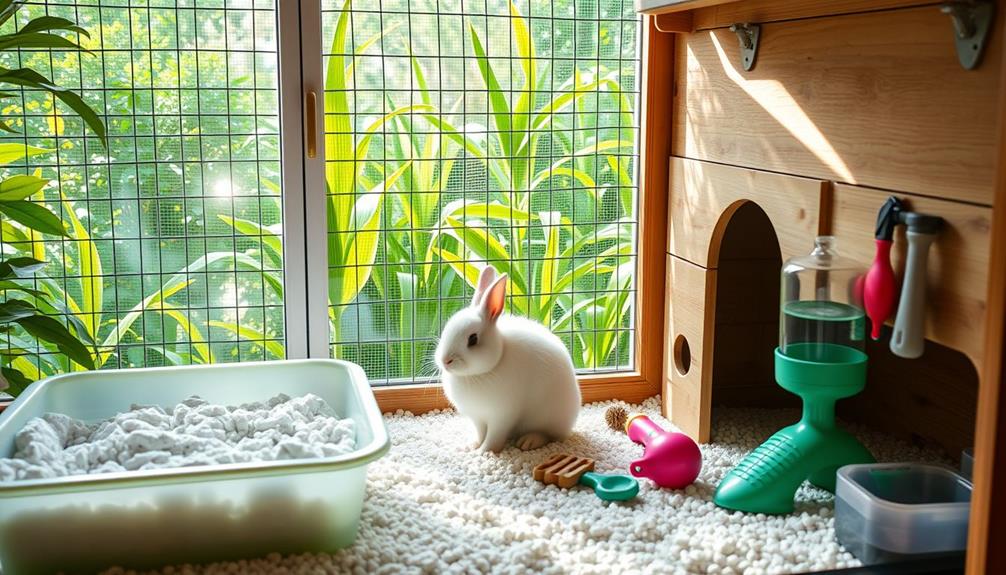
A clean living space is essential for your rabbit's health and happiness. Regular hygiene maintenance not only keeps your rabbit comfortable but also prevents health issues.
Daily cleaning of your rabbit's living area helps remove waste and uneaten food, while a full deep cleaning should happen weekly with pet-safe cleaners. Additionally, confirming that your rabbit's environment is free from irritants can contribute to their overall well-being, much like how hydration strategies optimize metabolism during physical activities.
To maintain a safe and hygienic environment, consider these key practices:
- Use safe bedding like newspaper, straw, or wood-based cat litter pellets to keep their space dry and chew-friendly.
- Create separate areas for sleeping, feeding, and toileting to simplify cleaning and promote a healthier habitat.
- Check water bowls daily to confirm they're clean and full of fresh water, preventing bacterial growth.
- Inspect the living area regularly for hazards and protect it from flying insects to avoid diseases like flystrike.
Dietary Essentials
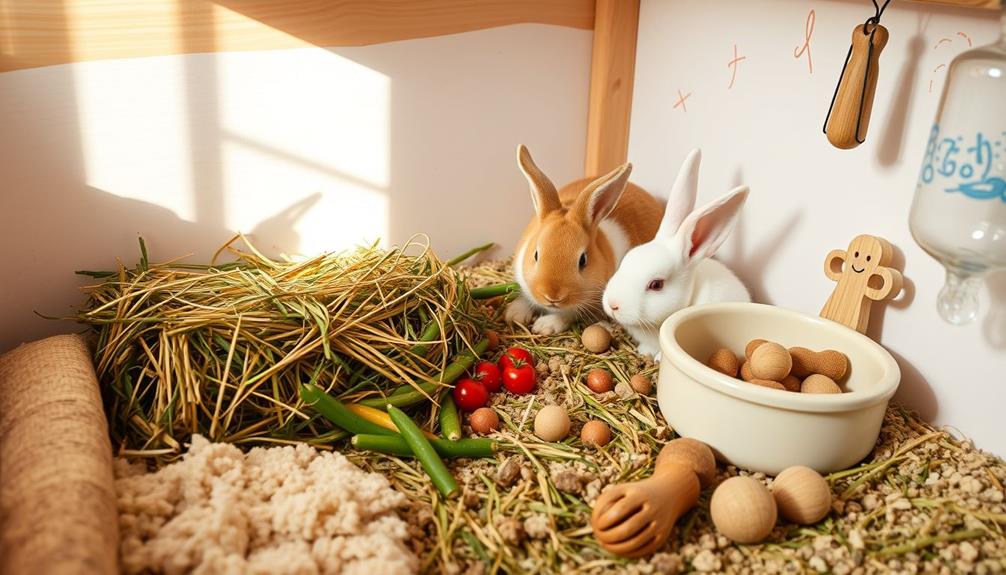
Rabbits thrive on a carefully balanced diet that prioritizes their unique nutritional needs. To guarantee your rabbit stays healthy, make high-quality grass hay, like Timothy or orchard hay, available 24/7. This should comprise about 80% of their diet, supporting their digestive health. Use a hay rack to keep it fresh and accessible.
Additionally, consider incorporating hair products for curly hair that contain natural ingredients, as they can help maintain your rabbit's coat health.
Introduce fresh greens gradually, focusing on darker leafy varieties. Aim for about 1 cup of greens per 2 pounds of your rabbit's body weight daily. Grass hay-based pellets can be included but should be rationed according to your rabbit's weight. Avoid pellets that contain seeds or nuts, as they can lead to health issues.
Treats like non-leafy vegetables and fruits should be offered in moderation. They should only make up a small portion of your rabbit's overall diet to prevent digestive problems and obesity.
Finally, guarantee your rabbit has fresh, clean water daily, preferably in a ceramic bowl or water bottle. Clean the bowl regularly to promote proper hydration and overall health.
Care During Absences
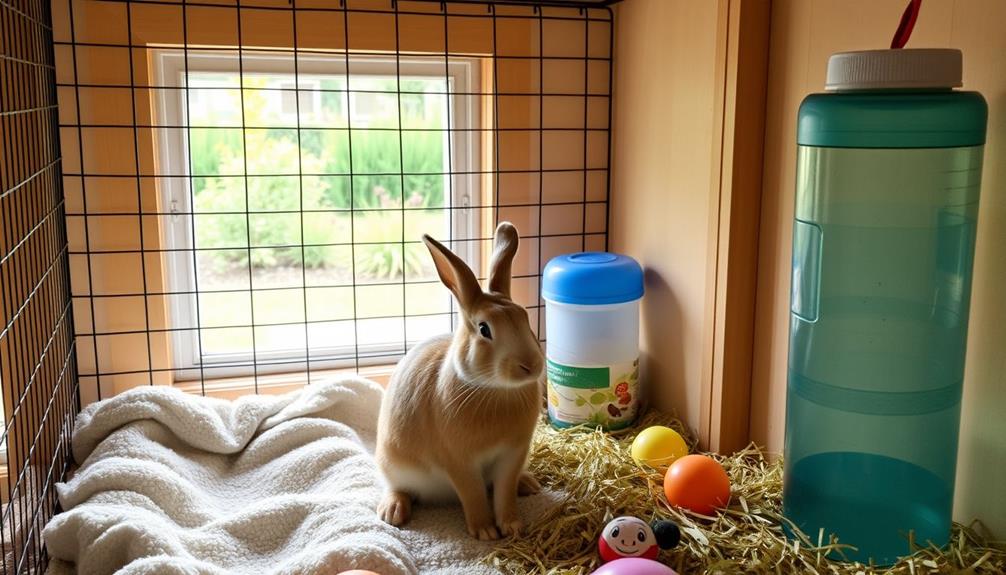
When you plan to be away, ensuring your rabbit receives proper care is essential for their well-being. To achieve this, you need to arrange for a reliable caretaker who understands rabbit needs. This caretaker should provide proper attention and create a secure environment for your pet.
Here are some key considerations for your rabbit's care during your absence:
- Keep grouped rabbits together: This helps maintain their comfort and reduces stress from separation.
- Use familiar items: Include toys or blankets in their transport carriers to provide a sense of security in a new environment.
- Ensure safe transport carriers: Choose carriers that are secure, comfortable, and well-ventilated to minimize stress during travel.
- Check environmental conditions: Make sure the caretaker's home has suitable size and temperature for your rabbits.
Frequently Asked Questions
How Do You Make a Rabbit Critical Care at Home?
To provide critical care for your rabbit at home, create a quiet, comfortable space, guarantee fresh water and a balanced diet, and monitor their health closely while maintaining a clean environment to promote recovery.
What Is the Perfect Home for a Bunny?
To create the perfect home for your bunny, guarantee it has ample space to run and jump. Incorporate safe sleeping and eating areas, provide fresh bedding, and include toys for enrichment and happiness.
Where Is the Best Place to Put a Rabbit Indoors?
The best place to put your rabbit indoors is a spacious, well-ventilated area free from drafts. Make certain it's safe from hazards and offers enough room for exercise, comfort, and mental stimulation. They'll thrive there!
How Do I Keep My House Clean With a Rabbit?
To keep your house clean with a rabbit, clean daily by removing waste and uneaten food. Establish designated toileting areas and use pet-safe cleaners weekly to eliminate odors and maintain a hygienic environment.
Conclusion
Creating the perfect home environment for your rabbit isn't just about meeting their basic needs; it's about ensuring they thrive. By understanding their unique requirements and providing a safe, clean, and stimulating space, you'll be setting the stage for a happy, healthy bunny. Remember, a little effort goes a long way—after all, you want your furry friend to hop around happily in their cozy haven. So, roll up your sleeves and get started on their ideal home!
